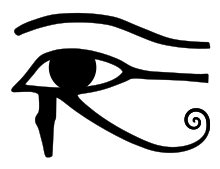Tatenen
Tatenen (also Ta-tenen, Tatjenen, Tathenen, Tanen, Tenen, Tanenu, and Tanuu) was the deity of the primordial mound in ancient Egyptian religion. His name means "risen land"[1] or "exalted earth",[2] as well as referring to the silt of the Nile. As a primeval chthonic deity,[3] Tatenen was identified with creation. Both feminine and masculine, he was an androgynous protector of nature from the Memphis area (then known as Men-nefer), the ancient capital of the Inebu-hedj nome in Lower Egypt.
| Part of a series on |
| Ancient Egyptian religion |
|---|
 |
|
Beliefs |
|
Practices
|
|
Deities (list) |
|
Locations |
|
Symbols and objects
|
|
Related religions
|
|
|
Tatenen represented the Earth and was born in the moment it rose from the watery chaos,[1] analogous to the primeval mound of the benben and mastaba and the later pyramids. He was seen as the source of "food and viands, divine offers, all good things",[4] as his realms were the deep regions beneath the earth "from which everything emerges", specifically including plants, vegetables, and minerals.[3] In the Third Intermediate Period hymn, The Great Hymn of Khnum, he is identified with the creator god Khnum, who created "all that is" on his potter's wheel.[5] This fortuity granted him the titles of both "creator and mother who gave birth to all gods" and "father of all the gods".[1][6] He also personified Egypt (due to his associations with rebirth and the Nile) and was an aspect of the earth-god Geb, as a source of artistic inspiration,[7] as well as assisting the dead in their journey to the afterlife.[8]
He is first attested in the inscriptions that mostly appear on Middle Kingdom coffins during the First Intermediate Period. In those inscriptions his name appears as Tanenu or Tanuu, 'the inert land', a name which characterizes him as a deity of the primeval condition of the earth. Middle Kingdom texts provide the first examples of the form Tatenen.[3]
With a staff, Tatenen repelled the evil serpent Apep from the Primeval Mound. He also had a magical mace dedicated to the falcon, venerated as "The Great White of the Earth Creator".[9] In one interpretation, Tatenen brought the Djed-pillars of stability to the country,[9] although this is more commonly attributed to Ptah.
Ptah-Tatenen

Both Tatenen and Ptah were Memphite deities. Tatenen was the more ancient, combined in the Old Kingdom with Ptah as Ptah-Tatenen, in their capacity as creator deities.[2] By the Nineteenth dynasty Ptah-Tatenen is his sole form, and he is worshiped as royal creator god. Ptah-Tatenen can be seen as father of the Ogdoad of Hermopolis, the eight deities who themselves embody the primeval elements from before creation.[3]
Portrayal
Tatenen's ambiguous portrayal may be a result of his being merged with Ptah. He was always in human form, usually seated with a pharaonic beard, wearing either an Atef-crown (as Ptah-Sokar) or, more commonly, a pair of ram's horns surmounted by a sun disk and two tall feathers.[3] As Tanenu or Tanuu, obviously a chthonic deity, he carried two snakes on his head.[3] He was both feminine and masculine because of his status as a primeval, creator deity.[1] Some depictions show Tatenen with a green complexion (face and arms), as he had connections to fertility and a chthonic association with plants.[2]
References
- Tatenen. Retrieved 2009-10-21.
- The Egyptian Gods Archived 2009-05-03 at the Wayback Machine Retrieved 2008-10-21.
- Tatenen Retrieved 2009-10-21.
- C. J. Bleeker. Historia Religionum I: Religions of the Past, p.68
- M. Lichtheim: Ancient Egyptian Literature, Vol.3, p.113
- J. H. Breasted: Ancient Records of Egypt, Part Three, § 411
- J. H. Breasted: Ancient Records of Egypt, Part Two, § 91
- Carol Andrews: The Ancient Egyptian Book of the Dead, spell 180
- Intersexed and Androgynous Deities in Religion or Mythology. Retrieved 2009-10-21.